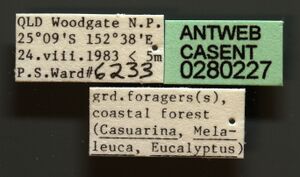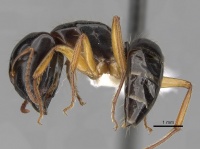Camponotus lownei
| Camponotus lownei | |
|---|---|

| |
| Scientific classification | |
| Kingdom: | Animalia |
| Phylum: | Arthropoda |
| Class: | Insecta |
| Order: | Hymenoptera |
| Family: | Formicidae |
| Subfamily: | Formicinae |
| Tribe: | Camponotini |
| Genus: | Camponotus |
| Species: | C. lownei |
| Binomial name | |
| Camponotus lownei Forel, 1895 | |
| Synonyms | |
| |
Identification
Keys including this Species
- Key to Australian Camponotus majors of the southwestern Botanical Province
- Key to Australian Camponotus minors of the southwestern Botanical Province
- Key to Australian Camponotus species
Distribution
Latitudinal Distribution Pattern
Latitudinal Range: 22.5045° to -35.3°.
| North Temperate |
North Subtropical |
Tropical | South Subtropical |
South Temperate |
- Source: AntMaps
Distribution based on Regional Taxon Lists
Australasian Region: Australia (type locality).
Distribution based on AntMaps
Distribution based on AntWeb specimens
Check data from AntWeb
Countries Occupied
| Number of countries occupied by this species based on AntWiki Regional Taxon Lists. In general, fewer countries occupied indicates a narrower range, while more countries indicates a more widespread species. |

|
Estimated Abundance
| Relative abundance based on number of AntMaps records per species (this species within the purple bar). Fewer records (to the left) indicates a less abundant/encountered species while more records (to the right) indicates more abundant/encountered species. |

|
Biology
Castes
Images from AntWeb
   
| |
| Worker. Specimen code casent0280216. Photographer Shannon Hartman, uploaded by California Academy of Sciences. | Owned by PSWC, Philip S. Ward Collection. |
   
| |
| Worker. Specimen code casent0280227. Photographer Shannon Hartman, uploaded by California Academy of Sciences. | Owned by PSWC, Philip S. Ward Collection. |
   
| |
| Worker. Specimen code casent0280228. Photographer Shannon Hartman, uploaded by California Academy of Sciences. | Owned by PSWC, Philip S. Ward Collection. |
   
| |
| Syntype of Camponotus lownei. Worker (major/soldier). Specimen code casent0910389. Photographer Z. Lieberman, uploaded by California Academy of Sciences. | Owned by MHNG, Geneva, Switzerland. |
   
| |
| Syntype of Camponotus lownei. Worker. Specimen code casent0910390. Photographer Z. Lieberman, uploaded by California Academy of Sciences. | Owned by MHNG, Geneva, Switzerland. |
Nomenclature
The following information is derived from Barry Bolton's Online Catalogue of the Ants of the World.
- nitida. Formica nitida Lowne, 1865a: 277 (s.) AUSTRALIA (New South Wales).
- [Junior primary homonym of Formica nitida Razoumowsky, 1789: 427.]
- Status as species: Dalla Torre, 1893: 202.
- Replacement name: Camponotus lownei Forel, 1895a: 43.
- lownei. Camponotus lownei Forel, 1895a: 43.
- Replacement name for Formica nitida Lowne, 1865a: 277. [Junior primary homonym of Formica nitida Razoumowsky, 1789: 427.]
- Crawley, 1922c: 33 (q.m.).
- Combination in C. (Myrmophyma): Forel, 1914a: 269;
- combination in C. (Myrmogonia): Emery, 1920b: 257;
- combination in C. (Thlipsepinotus): Santschi, 1928e: 483.
- Status as species: Emery, 1896d: 374 (in list); Forel, 1902h: 494; Forel, 1907a: 34; Forel, 1915b: 102; Crawley, 1922c: 33; Emery, 1925b: 111; Taylor & Brown, 1985: 116; Taylor, 1987a: 13; Bolton, 1995b: 109; McArthur, 2007a: 340; Heterick, 2009: 68; McArthur, 2010: 72; McArthur, 2014: 126.
Type Material
- Formica nitida Lowne, 1865: Holotype, major worker, Sydney (as Sidney), New South Wales, Australia, The Natural History Museum.
Unless otherwise noted the text for the remainder of this section is reported from the publication that includes the original description.
Description
Worker major Length 7.5-8 mm. The head (without the mandibles) 2 mm long by 1.8 mm wide, nearly square, a little wider behind than in front, strongly indented behind. Mandibles short, obtuse, punctate, armed with 5 teeth. Clypeus without lobe and almost without a keel, indented in the middle and on each side. A transverse and curved impression laterally on the cheeks. The front of the head is feebly subtruncate up to the articulation of the antennae as in Colobopsis truncata worker. The thorax very short, very rapidly narrowing behind, dorsum strongly convex; meso-metanotal suture indistinct. Basal face of the metanotum (= propodeum) very short, narrow and very convex. Declivity face very high, very abrupt, subvertical. Node oval,sharp,pointed. Gaster oval. Glossy, feebly shagreen; sides of the thorax sub opaque, more strongly wrinkled or wrinkled reticulate. Large fossae, widely spaced, pilogerous, on front, the vertex, and the dorsum of the thorax. Widely spaced punctation,regular on the cheeks. The rest of the body without punctation. Pilosity yellow, sparse,none on the tibia or tarsi which have a slightly raised pubescence. Pubescence very short and sparse elsewhere. Black. Limbs and gastric segments of a light yellow, a little testaceous. Antennae and tarsi of a reddish yellow. Border of the mandibles dark reddish.
Worker minor. Length 4.7 to 5 mm. Head trapezoidal, wider behind than at the front. The eyes situated near the back. Clypeus convex, without a median indentation. Meso-metanotal suture obsolete. The entire metanotum forms a strong convexity; basal face as long as the declivity. Node thicker, not pointed. Pilosity noticeably more abundant and longer than the major worker; on the tibias and scapes, the pubescence becomes oblique pilosity. Fossae and points much more sparse and weaker than in the worker major. Color a little lighter than the major; mandibles and anterior border of the head a brownish yellow.
Mackay, Queensland, M Gilbert Turner.
This species appears to be without doubt a relative of C.nitidus Lowne.
References
- Crawley, W. C. 1922e. New ants from Australia (concluded from vol. ix. p. 449). Ann. Mag. Nat. Hist. 9(10): 16-36 (page 33, queen, male described)
- Emery, C. 1920b. Le genre Camponotus Mayr. Nouvel essai de la subdivision en sous-genres. Rev. Zool. Afr. (Bruss.) 8: 229-260 (page 257, Combination in C. (Myrmogonia))
- Forel, A. 1895a. Nouvelles fourmis de diverses provenances, surtout d'Australie. Ann. Soc. Entomol. Belg. 39: 41-49 (page 43, Replacement name for Formica nitida)
- Forel, A. 1914a. Le genre Camponotus Mayr et les genres voisins. Rev. Suisse Zool. 22: 257-276 (page 269, Combination in C. (Myrmophyma))
- Heterick, B.E. 2021. A guide to the ants of Western Australia. Part I: Systematics. Records of the Western Australian Museum, Supplement 86, 1-245 (doi:10.18195/issn.0313-122x.86.2021.001-245).
- Heterick, B.E. 2022. A guide to the ants of Western Australia. Part II: Distribution and biology. Records of the Western Australian Museum, supplement 86: 247-510 (doi:10.18195/issn.0313-122x.86.2022.247-510).
- Lowne, B. T. 1865a. Contributions to the natural history of Australian ants. Entomologist 2: 275-280 (page 277, [Junior primary homonym of Formica nitida Razoumowsky, 1789: 427.] )
- Santschi, F. 1928e. Nouvelles fourmis d'Australie. Bull. Soc. Vaudoise Sci. Nat. 56: 465-483 (page 483, Combination in C. (Thlipsepinotus))
References based on Global Ant Biodiversity Informatics
- McArthur A. 2010. A guide to Camponotus ants of South Australia. Adelaide: South Australian Museum, IV + 121 pp.

